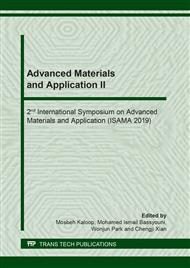p.100
p.109
p.116
p.122
p.128
p.134
p.141
p.146
p.155
Microwave Assisted Extraction (MAE) Process of Tannin from Mangrove Propagules Waste as Natural Dye for Coloring Batik tulis
Abstract:
Mangrove propagule waste is one of the biomass wastes that decays fast, hence it can pollute the environment. Mangrove propagule contains 30.43% tannin, and thus it has high potential to be used as a natural dye for coloring Batik Tulis. Unfortunately, this raw material has not been utilized optimally. The objective of this study is to extract tannin substances from mangrove propagules by using Microwave Assisted Extraction (MAE) method. The effects of solvent types (i.e. ethanol and distilled water), material-solvent ratio, extraction time and temperature on the yield of tannin obtained have also been investigated. The extraction results were analyzed by FT-IR to determine the presence of tannin contained in the dyes. The extraction results showed that the optimum yield of etanol solvent was 27.5%, which occured at material-solvent ratio of 0.04 g/ml, extraction time of 30 minutes, and temperature of 60°C. Whereas, the distilled water produced 22.7% yield of tannin, which also occured at material and solvent ratio 0.04 g/ml, extraction time of 30 minutes, and temperature of 80°C. Additionally, FT-IR analysis of tannin extract from mangrove propagules with etanol and distilled water showed the presence of hydroxyl groups (O-H), groups (C-H), C = C groups, and C-O groups.
Info:
Periodical:
Pages:
128-133
Citation:
Online since:
June 2019
Keywords:
Price:
Сopyright:
© 2019 Trans Tech Publications Ltd. All Rights Reserved
Share:
Citation:


